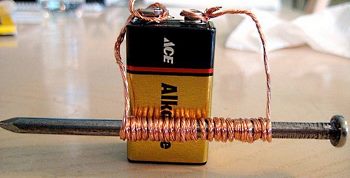property>magnetic moment
What is Magnetic Moment?

For any given electromagnetic system, there is a measure of both the strength and direction of its magnetism known as the magnetic moment. Measured in SI units of joules/tesla, the magnetic moment serves to quantify the way in which the internal magnetic properties of the system contribute to the system’s external magnetic field (also known as the part of the external magnetic field with a strength that drops off with an inverse cubic rule as a function of distance). Because there are no known magnetic monopoles, the magnetic moment most commonly refers to the magnetic dipole moment. The vector for the magnetic moment runs along the naturally occurring axis of the dipolar magnetic field pattern. There are other higher order magnetic moments, such as the quadrupolar and octupolar variants, but they are uncommon.
Typically, when determining the magnetic moment, we are investigating one of two things. We are either looking at a system that involves the motion of electric charges (also known as an electric current) or we are trying to determine the intrinsic magnetism of some kind of elementary particle like the electron. Depending on what we are doing, we will go about calculating the magnetic moment in different ways.
Circular Coil Magnetic Moment
If there is a circular loop that carries current, we find that there is an analogous relationship between the magnetic moment of the coil and angular momentum in mechanical physics. This is known as the “magnetization by rotation” effect. For a given area, A, determined by the circle around which the loop of current I flows, the magnetic moment, μ, is given by the following equation:
μ = I.A
where the direction of the magnetic moment runs perpendicular to the surface of the circle made by the loop of current. Having calculated this number, we would be able to determine the magnetic field strength at a given distance from the magnetic dipole.
A solenoid is another type of circuit that produces a magnetic field. As a child you have may have made an electromagnet with an iron nail and a copper wire wrapped around it and attached to a battery. To calculate the magnetic moment of a solenoid, you just multiply the magnetic moment you get from a single coil by the number of coils you have wrapped around the nail. Just as above, the direction of the magnetic moment vector will run perpendicular to the surface of the circle made by the coil.
The above calculations will work for large scale systems, but what if we want to know the magnetic moment of a single electron? All macro-scale systems are fundamentally reliant on, and derive their magnetic nature from, elementary particles. To find the magnetic moment of a single electron, we use the following equation:
μs = -gs.μb.(S/ħ)
where μ_s is the magnetic moment of an electron, gs is the electron g-factor which is a proportionality constant that relates observed magnetic moments to an angular momentum quantum number such as μb, the Bohr magneton. S is the electron spin, and ħ is the reduced Planck constant. gs has a value of 2.00231930436. It must be noted that the direction of an electron’s magnetic moment will always run anti-parallel to the electron spin.